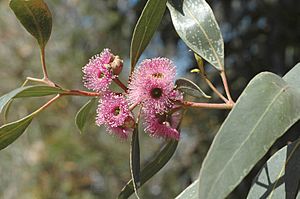Purple-flowered mallee box facts for kids
Quick facts for kids Purple-flowered mallee box |
|
|---|---|
 |
|
| Eucalyptus albopurpurea (cultivated specimen) | |
| Scientific classification | |
| Genus: |
Eucalyptus
|
| Species: |
albopurpurea
|
| Synonyms | |
|
|
The purple-flowered mallee box, also known as Eucalyptus albopurpurea or the Port Lincoln mallee, is a special type of plant found only in South Australia. It can grow as a mallee, which is a small, bushy tree with many stems, or sometimes as a taller tree. This plant has rough, grey-brown bark on the bottom part of its trunk. Higher up, the bark is smooth and peels off in strips. Its leaves can be shaped like a spear or an egg. The flower buds look like spindles or clubs. When the flowers open, they can be white, pink, light purple, or dark purple. This plant can flower almost any time of the year. Its fruit are shaped like cups or barrels.
Contents
What Does the Purple-Flowered Mallee Box Look Like?
The Eucalyptus albopurpurea is usually a mallee. This means it's a small, multi-stemmed tree that grows up to 5 m (20 ft) tall. Sometimes, it can grow as a single-trunk tree, reaching 5–18 m (20–60 ft) high. It has a special woody swelling at its base called a lignotuber. This helps the plant regrow after fires.
The bark on the lower part of the trunk is rough, loose, and grey-brown. Higher up, the bark is smooth and can be coppery or pinkish-grey. This smooth bark peels off in long strips.
Leaves and Flowers
Young plants and new shoots have leaves that grow in opposite pairs. These leaves are broad and shaped like a spear or an egg. They are 40–110 mm (2–4 in) long and 23–47 mm (0.9–2 in) wide. Both sides of these young leaves are a dull bluish-green.
Adult leaves grow one after another, not in pairs. They are shaped like a spear, measuring 70–140 mm (3–6 in) long and 12–30 mm (0.5–1 in) wide. Each adult leaf has a stalk called a petiole, which is 10–20 mm (0.4–0.8 in) long. Both sides of the adult leaves are a shiny, dark green.
The flower buds grow in groups on branching stems called inflorescences. Each group has between seven and eleven flowers. The main stalk holding these flower groups is called a peduncle, and it is 7–20 mm (0.3–0.8 in) long.
Mature flower buds are shaped like clubs or are oblong. They are 6–10 mm (0.2–0.4 in) long and 3–4 mm (0.1–0.2 in) wide. Each bud sits on a small stalk called a pedicel, which can be up to 4 mm (0.16 in) long. The cap of the bud, called the operculum, is shaped like a cone or is rounded.
The flowers can be white, pink, light purple (mauve), or dark purple. They can appear in most months of the year. After flowering, the plant produces fruit. These fruit are shaped like cups or barrels, or sometimes like cylinders. They are 6–10 mm (0.2–0.4 in) long and 5–8 mm (0.2–0.3 in) wide. These fruit are actually capsules that hold the seeds.
How Did It Get Its Name?
The purple-flowered mallee box was first officially described in 1974. A scientist named Clifford David Boomsma gave it the name Eucalyptus lansdowneana subsp. albopurpurea. He published his description in a journal called South Australian Naturalist. He studied a plant sample collected by Reginald Allan Dorward.
Later, in 2000, another scientist named Dean Nicolle decided that this plant was different enough to be its own species. So, he changed its name to Eucalyptus albopurpurea.
The second part of its scientific name, albopurpurea, comes from two Latin words. Albus means "white," and purpureus means "purple." This name was chosen because the flowers can be either white or purple, showing the different colors they can have.
Where Does It Grow?
The Eucalyptus albopurpurea is only found in a few specific places in South Australia. You can find it on Kangaroo Island and at the very southern tip of the Eyre Peninsula. It likes to grow on sandhills close to the ocean. It also grows in areas that get wet during certain times of the year.

